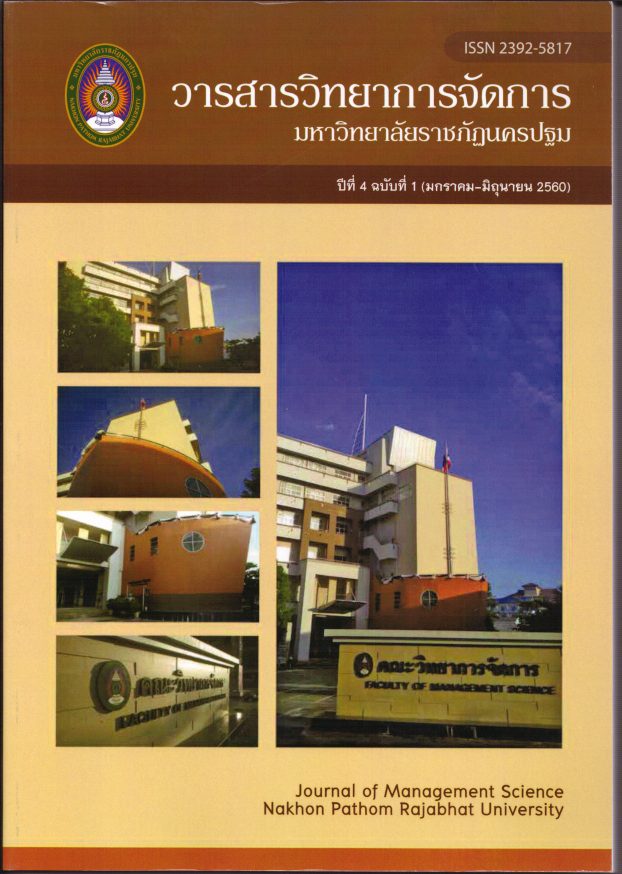The Efficiency of The Employees’ Performance in The Hospitality Services – Hotels and Resorts. In The Area of Koh Chang Trat Province.
Main Article Content
Abstract
The purposes of this dissertation are: (1) to study factors that directly or indirectly affect workforce administration to increase the efficiency of the employees’ performance in the hospitality services - hotels and resorts in the area of Koh Chang Trat province. (2) to study directions the efficiency of the employees’ performance in the hospitality services - hotels and resorts in the area of Koh Chang Trat province The mixed methods research design was used. Quantitative data was collected from 400 samples including human resource managers, marketing managers, management managers, and assistant managers of each department. The data were analyzed by descriptive statistics such as Mean and Standard Deviation. Structural Equation Model (SEM) was used to verify the consistency of the model and the data. For qualitative research, in-depth interviews were conducted with 10 samples who were the owners or executives employed by the owners. The results from the analysis and interviews were discussed.
The research found that:
(1) Workforce administration to increase the efficiency of the hospitality industry was positively influenced by the following factors: Policy Managment (β = .465); Motivation (β = .461); Technology (β = .311). While Motivation was found to be casual factor (β = .254) that directly affected the efficiency of the employees’ performance. Policy Management (β = .455) and Technology (β = .331) directly affected the efficiency of the employees’ performance (β = .210) and Policy Management (β = .217)
(2) In order to administrate workforce to increase the efficiency of the hospitality industry, the executives focus on the use of technology that is appropriate to the work of the organization. The meetings were held to collaboratively set up a plan and allowed everyone to get involved, exchange information, and create a corporate culture together taking into account of the customers’ satisfaction, both external and internal customers. The employees shall perform based on the facts in order to achieve a continuous improvement process in a standardized approach and reduce duplication of errors. This increases productivity indirectly. It also motivates employees to cooperate with the organization and to motivate them to work.
Article history : Accepted 5 May 2017
SIMILARITY INDEX = 0.00
Article Details
The views and opinions of the article appearing in this journal are those of the author. It is not considered a view and responsibility of the editorial staff.
References
กรมการท่องเที่ยว. (2559). สถิตินักท่องเที่ยวชาวต่างชาติที่เดินทางเข้าประเทศไทย. [ออนไลน์]. ค้นเมื่อ 16 ตุลาคม 2559. จาก https://www.tourism.go.th/view/3/สถิตินักท่องเที่ยวชาวต่างชาติที่เดินทางเข้าประเทศไทย_สนามบินสุวรรณภูมิ/TH-TH.
พวงรัตน์ ทวีรัตน์. (2543). วิธีการวิจัยทางพฤติกรรมศาสตร์และสังคมศาสตร์. (พิมพ์ครั้งที่ 7) กรุงเทพมหานคร : สำนักทดสอบทางการศึกษาและจิตวิทยา มหาวิทยาลัยศรีนครินทรวิโรฒ.
พิชญา วัฒนรังสรรค์. (2558). การเพิ่มประสิทธิภาพในการปฏิบัติงานของพนักงานโรงแรมระดับ 4 ดาว ย่านสยามสแควร์. วารสารวิจัยและพัฒนา วไลยอลงกรณ์ ในพระบรมราชูปถัมภ์. สาขามนุษย์ศาสตร์. 11 (1), 71-79.
สำนักงานคณะกรรมการพัฒนาระบบราชการ. (2549). การพัฒนาคุณภาพการบริหารจัดการภาครัฐ. [ออนไลน์]. ค้นเมื่อ 5 มีนาคม 2559 จาก https://www.opdc.go.th.
Adams, M & Ranney, G. (1994). Beyond Total Quality Management- toward the emerging paradigm, International Editions, Tata McGraw Hill.
Bollen, K.A. (1989). Structure Equation with Latent Variables. New York : wiley.
Buytendijk, F (2006) The Five Keys to Building A High-Performance Organization. (Online) Retrieved October 18, 2016 from http// businessfinancemag.com.
Carter, C. C. (1994). Human resources management and the total quality imperative. New York : AMACOM.
Cochran, W.G. (1977). Sampling Techniques. (3rd ed.) New York : John Wiley and Sons Inc.
Creswell, J. (2009). Research Design: Qualitative, Quantitative and Mixed Methods Approaches. (Fourth Edition). Nebraska: Sage Publication Ltd.
Dale, B. G. , Boaden, R. J. , & Lascelles, D. M. (1994). Total quality management: An overview. In Dale, B. G. (ed.) Managing quality. New York: Prentice-Hall.
De Cenzo, D. A. , & Bobbing, S. P. (1996). Human resource management (5th ed.) New York : John Wiley & Sons.
Gronfeldt, S. & Strother, J. (2006). Service Leadership. USA : SAGE Publication.
Graham, H. T.,& Bennett, R. (1998). Human resource management. (9th ed.) London : Financial Times Management.
Kano, Noriaki; Nobuhiku Seraku; Fumio Takahashi; Shinichi Tsuji (1984). Attractive quality and must-be quality. Journal of the Japanese Society for Quality Control (in Japanese). 14 (2): 39–48.
Lakhe, R. R. & Mohanty, R. P. (1994). Total quality management: Concept, evolution and acceptability in developing economics. International Journal of Quality & Reliability Management. 11 (9). 9-33.
Rothwell, R. (1994). Towards the Fifth-generation Innovation Process. International Marketing Review. 11,(1), -31.
Seashore & Yuchtman (1991). Factorial Analysis of Organizational Performance. Administrative Sciences Quarterly. 12(1), 377-395.
Stebbing, L. (1993) Quality management in the service industry. New York : Ellis Harwood.
Wilkinson, A. (1994). Managing human resources for quality. In Dale, B.G. (Ed.). Managing quality. New York : Prentice-Hall.
World Tourism Organization. (2016). Tourism Situation 2020. Retrieved October 18, 2016, from https://www2.unwto.org/.

